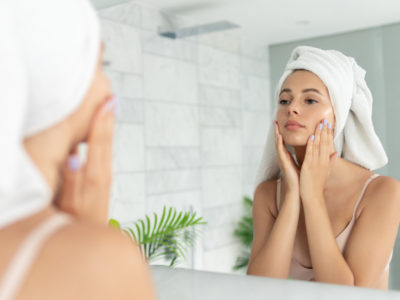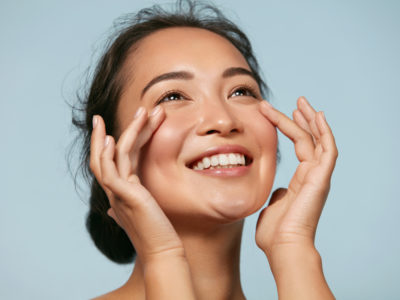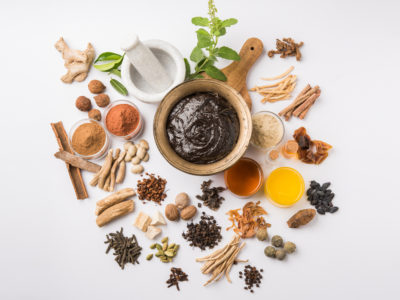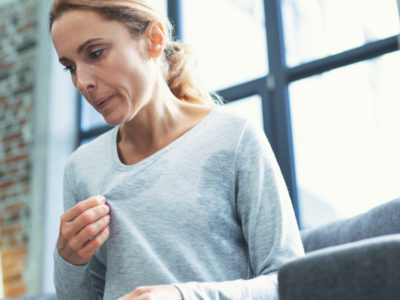Table of Contents[Hide][Show]
Brown spots, liver spots, age spots… Whatever you call them, these small, flat areas of darker pigmentation can crop up unexpectedly. And while age spots are harmless, you might not enjoy seeing them on your skin.
Luckily, with a little help and know-how, it’s not too late to improve your skin’s appearance.
See below for strategies you can start using today that will:
- Lighten or remove existing age spots
- Prevent new age spots from forming
- Keep existing age spots from getting darker
What Causes Age Spots
Although they’re often referred to as aging spots, they actually have to do less with age than with prolonged exposure to UV rays. This is why they mostly show up on parts of your body that get the most sun: face, hands, shoulders and arms.
They are more common after the age of 50, simply because that’s when years of accumulated sun damage begin to show in your skin. But younger people can get them too, especially if they frequently spend time outdoors or in a tanning bed.
Concerned that you’ve spent a little too much time worshipping the sun? Here are our top picks for the most effective ways to recover and retain your youthful skin.
How to Get Rid of Aging Spots
1. Skin Lightening Creams and Lotions
If you visit the beauty aisle of the drug store or a department store makeup counter, you’ll see dozens of products all advertising the same thing: reduce or eliminate brown spots/pigmentation. But not all of them will have the same ingredients nor the same effectiveness. Upon closer inspection, you’ll likely notice that the ingredients can differ greatly from product to product (and some will be a lot healthier for your body than others.)
According to dermatology experts, three of the top health-positive ingredients to look for include: tranexamic acid, niacinamide, and kojic acid. Here’s why:
Melanin is the pigment that gives color to your eyes, hair, and skin. The ingredients above have all been shown to block the formation of tyrosine, an amino acid that supports melanin production. By reducing or even halting the production of melanin, they work to lighten the appearance of dark spots.
2. Medications
A popular approach to de-aging your skin is to talk to your doctor or dermatologist. For aging spots, there are prescription medications that will help lighten, brighten, or completely remove them.
Bleaching creams that contain hydroquinone can be paired with retinoids or a mild steroid. Consistent use has been shown to fade sun spots and even skin tone.
The medication can also cause heightened sun sensitivity. Try to avoid sun exposure, and use a good broad spectrum sunscreen daily, with an SPF of at least 30, if you must be in the sun.
Related
14 Beneficial And Harmful Chemicals Your Skin Absorbs
Ever wonder what chemicals the skin absorbs and how they affect your health? Learn which chemicals in skincare to avoid and those that are safe.
3. In-Office Procedures
There are a number of medical procedures that can help reduce or remove brown spots. Your doctor will schedule an initial consultation to examine your skin and recommend the best course of action.
- Laser or intense pulsed light therapy (IPL) : Narrow beams of light are concentrated on the areas where you have age spots. This non-invasive laser treatment can target melanocytes, the cells that produce melanin, without damaging the rest of your skin.
- Cryotherapy: Your doctor will use a cotton swab to apply liquid nitrogen to your brown spots for a few seconds. This will destroy the extra pigment. And as your skin heals it will lighten.
- Dermabrasion: A spinning brush is used to “sand” the surface of your skin. It removes the skin with sun damage so new, healthy, clear skin can grow in its place.
- Microdermabrasion: This procedure is similar to dermabrasion but less aggressive. Instead of a spinning brush, tiny crystals are used to “sand” the skin and promote the growth of new, spot-free skin.
- Microneedling: Your doctor will use fine needles to make tiny, evenly-spaced holes on your skin. Your body then produces elastin and collagen to heal the damage, improving signs of aging – including brown spots.
- Chemical Peel: A chemical solution applied to your skin will remove its topmost layers. This will reveal undamaged, new skin below.
Most of these procedures are quick treatments that can be done in the office, with very little downtime. The number of treatments required and the length of time to see results will vary depending on your skin.
Because melanin is located within your epidermis (the top layer of skin), treatments to lighten brown spots have to penetrate that layer. As a result, some of these procedures will have side effects such as redness, swelling, scabbing, blistering, and more. Your dermatologist will fill you in on what to expect post-treatment.
4. Lemon Juice
Ready to try an all-natural aging spot remedy? Lemon juice contains two important skin care ingredients: citric acid and vitamin C. Both of these work as brightening agents and can help fade or even remove your sun spots.
Before you begin, test the lemon juice on your skin to make sure it’s not too harsh for you. If you feel any sensitivity, dilute it with equal parts water.
Squeeze fresh lemon juice onto a cotton ball (if using on its own) or in a bowl (if diluting with water) and apply it directly to any aging spots. Let it sit on your skin for no more than 20 minutes before you rinse it off. Even when diluted, lemon juice can cause skin sensitivity. Use it just 2-3 times per week, and discontinue use if you experience any irritation.
Related
Is Non-Toxic Makeup also Natural and Organic?
Sort out the non-toxic makeup brands from the pretentious ones. Read on to understand the buzzwords and learn how to choose natural, organic, non-toxic makeup and personal care products.
5. Potatoes
Extra carbs might not be the best choice inside your body, but this carb can certainly help outside your body!
The starch and sugar in potatoes both work as exfoliants (removing dead skin) and allow the new, undamaged cells underneath to come to the surface.
To give this DIY remedy a try, thinly slice a russet potato and moisten slightly with water. Apply the slices to your skin, covering all of your age spots. Leave them in place for 10 minutes. Potatoes are mild enough to use every day.
6. Honey
Honey is one of Mother Nature’s top antibacterial remedies. It’s been used for thousands of years for both cosmetic and medicinal purposes.
The natural sugar contained in honey is its exfoliator, so choose a honey that contains over 80 percent sugar. As dead skin cells are sloughed off, new, unpigmented cells will be revealed.
To use honey to fight brown spots, simply rub it onto any aging spots with your fingertips. Allow it to work its magic for 20 minutes before rinsing it off. Honey is so mild that you can use it on your skin every day.
7. Buttermilk
Ever hear of Cleopatra’s famous milk baths? Turns out, there’s actual science behind the ancient claims of milk’s cosmetic properties!
Buttermilk, milk, and yogurt all contain lactic acid, which is one of the mildest forms of alpha hydroxy acid (AHA). Lactic acid can exfoliate the dead, pigmented cells sitting on the top layer of your skin, speeding up cell turnover and lightening the pigmentation.
Saturate a cotton ball in buttermilk and place it on your brown spots. Leave them on your skin for 20 minutes before rinsing your skin. Buttermilk, milk, and yogurt are all gentle enough to use daily.
How to Prevent Aging Spots
There’s a reason mom always reminded you to use sunscreen! Because age spots are caused by harmful UV rays, reduced sun exposure is crucial in the prevention of age spots. It’s also important to protect your skin from the sun to avoid the more serious disease of skin cancer. Here are a few ways to keep safe from those bright rays.
- Try to avoid being outdoors during the sunniest part of the day: typically from 10 a.m. to 3 p.m.
- Always wear sunscreen when you’ll be outdoors, even on cloudy days. This is the most important thing you can do to prevent aging skin, especially brown spots.
- Wear protective clothing—hats, gloves, long-sleeved shirts—to cover your sun spots. This will help keep them from darkening.
- Choose outdoor clothing (rash guards, shorts) with a UPF (ultraviolet protection factor) of at least 40.
- If you spend a lot of daytime hours driving, look into getting ultraviolet protection on your car’s windows.
And remember, sun spots can—and will!—come back. If you use one of our methods to lighten or remove your sun spots it’s crucial to be proactive in preventing the appearance of age spots from resurfacing to maintain your skin’s brighter appearance.
Final Thoughts
You don’t have to accept skin discoloration as part of aging. There are a number of spot treatment options to reduce and eliminate age-related lesions , ranging from natural remedies all the way to medical procedures. And the best part is, you can mix and match most of these to find the best solution for your skin.
And don’t forget the importance of prevention! Prevent brown spots from forming and keep existing brown spots from getting any darker with savvy sun protection techniques. Limit your UV exposure as much as possible. And always wear your sunscreen!
You May Also Like…
Editor’s Note: This post was originally published on August 26, 2021, and has been updated for quality and relevancy most recently on December 16, 2021.






